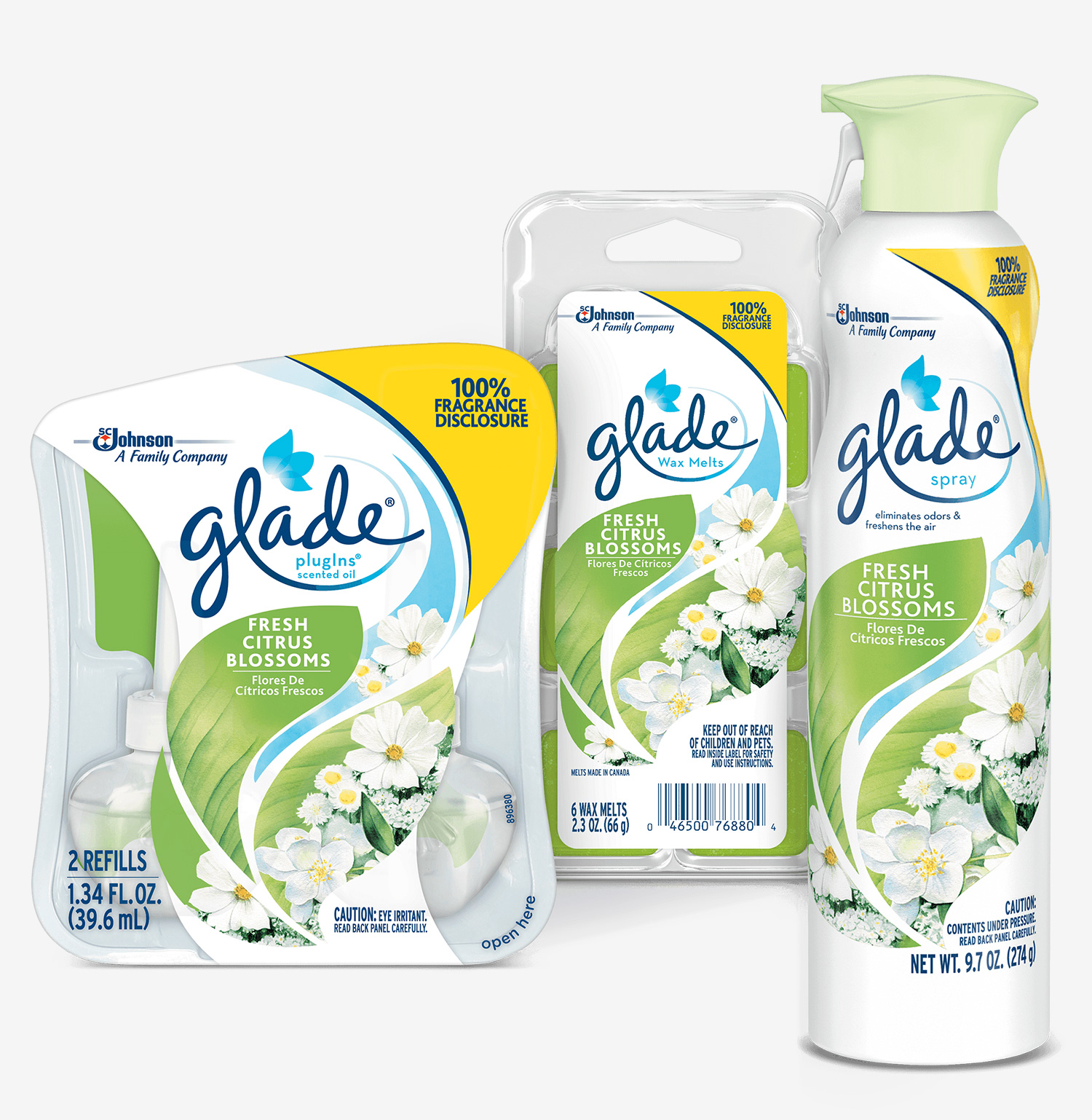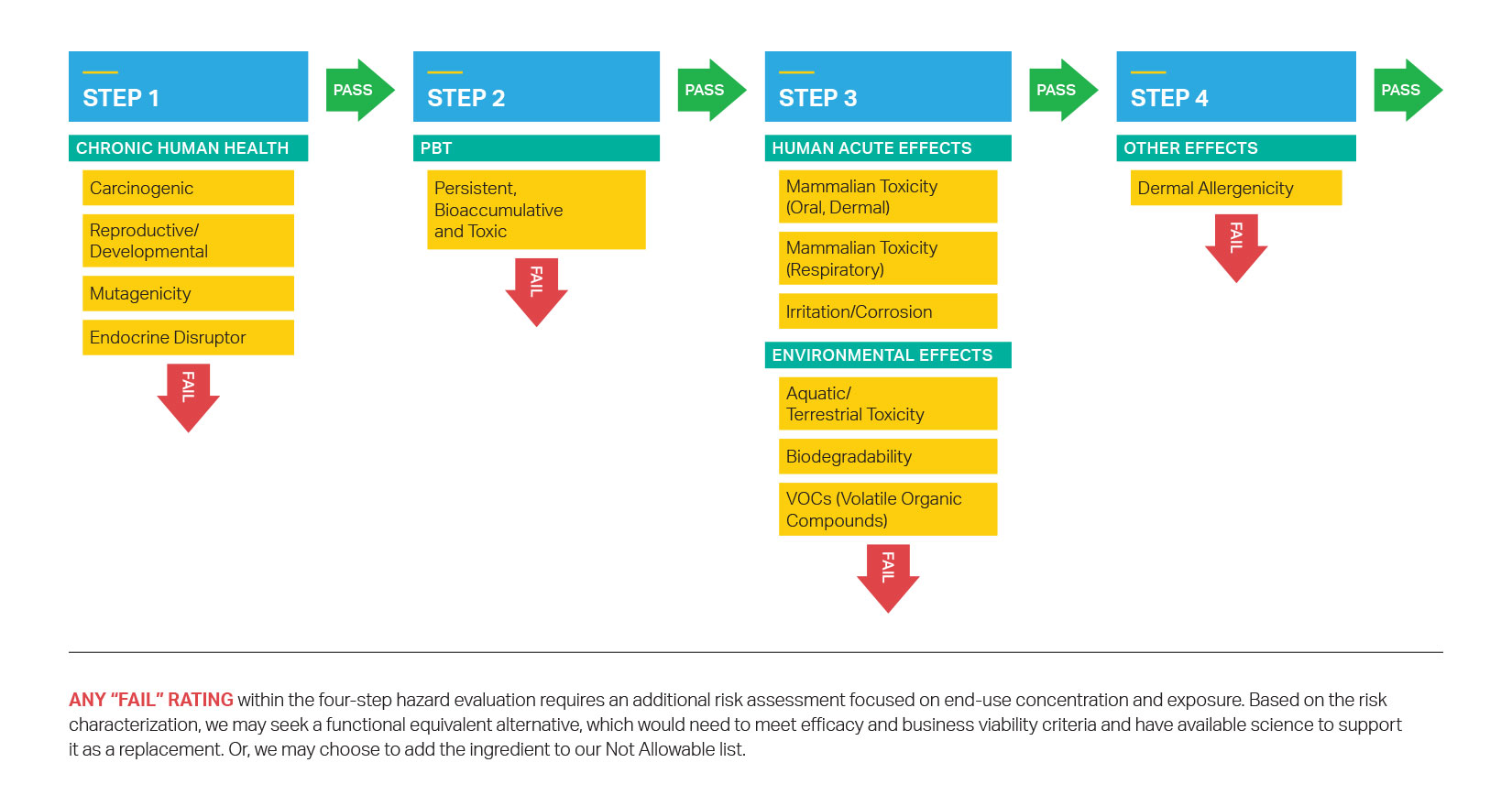
Every ingredient in every SC Johnson product goes through the rigorous Greenlist™ program. Its centerpiece is a science-based, four-step evaluation that looks at both hazard and risk. It’s grounded in best-in-class data collection, and driven by our commitment to continually improve our products.
The four-step evaluation at the heart of the Greenlist™ program looks at these criteria:
- Chronic human health hazards, such as the potential to cause cancer or reproductive diseases
- Long-term environmental hazards, meaning the potential to persist, accumulate and be toxic in the environment
- Acute risks to human and environmental health, such as mammalian or aquatic toxicity
- Other potential effects, for example whether an ingredient could cause an allergic reaction on the skin
If an ingredient passes the four steps but does not reach the highest achievable level on each of the criteria, the results can be used by SC Johnson scientists to search for more desirable ingredient options. This pushes our scientists to use better and better ingredients in the reformulation of existing products or the development of new ones.
We take great care to choose ingredients that pass each of the steps in our four-step evaluation process. There are a small number of cases where the best available ingredient, like the active ingredient in an insecticide, might fail one of these steps. If so, it goes through a risk assessment to determine the level that is safe for humans and the environment, and we then apply an added degree of caution.
The risk assessment uses a built-in safety factor that ensures the concentration of the ingredient is multiple times lower than the lowest concentration that could possibly cause impacts to human health or the environment.
In some cases, the assessment may show that the ingredient’s concentration in the product would be lower than the acceptable level, making it allowable for use in our products. In other cases, we may choose to phase out the ingredient altogether, looking at how we can replace it with an alternative that has validated science proving it to be a better choice. The packaging, use instructions or other features might also be altered to mitigate exposure.
For example, take table salt, or sodium chloride. Used excessively, there’s a hazard of high blood pressure associated with salt. But used very sparingly, the risk of salt affecting blood pressure is low. That’s because the difference between a hazard and a risk is generally affected by the concentration and the way a person or the environment is exposed to the ingredient.
While some advocate for hazard-based standards, at SC Johnson we think that would be an overreaction – just as you wouldn’t need to eliminate salt if you don’t have a history of high blood pressure. In fact, salt is essential for life. We would die without it. Rather, we believe in a combined approach that looks at hazard and risk to make the most informed choices about ingredient use.
Importantly, we explore a wide range of possible avenues for exposure, to determine a “safer than safe” level of the ingredient in question and minimize any concerns associated with its use.
We also won’t give an ingredient a pass simply because it’s commonly used in our industry, or has government approval. The Greenlist™ program is about evaluating the science to determine what’s right, which sometimes makes our standards stricter than the conventional wisdom.
The first, and perhaps most critical, step in the Greenlist™ four-step evaluation looks at whether any valid scientific evidence indicates that an ingredient could cause chronic human health conditions. This includes evidence of exposure resulting in cancer, reproductive or developmental impacts, mutagenicity or endocrine disruption. Given the gravity of these impacts, and the high level of concern they may cause consumers, they are considered first in our evaluation.
Our data sources for Step 1 include:
- California Proposition 65 (CA Prop 65), the state’s annually updated list of chemicals known to cause cancer, birth defects or other reproductive harm
- The World Health Organization’s International Agency for Research on Cancer (IARC) monographs, which include evaluations for more than 1,000 materials
- Categorization of potential hazards by the EU and the U.S. Occupational Safety and Health Administration (OSHA)
- High-quality laboratory studies and predictive modeling on specific ingredients where available
Ingredients pass this evaluation if they meet our criteria and are categorized as either Acceptable or Best. Our commitment to continuous improvement includes looking for opportunities to move up from Acceptable to Best when possible. If any ingredient fails to meet either of those levels, it triggers a risk assessment as explained above.
We take an abundance of precaution with Step 1, and the vast majority of ingredients we use pass this step. Of the very few ingredients that fail, which tend to be ingredients in products like insecticides, we set a safety factor that is over a thousand times lower than the lowest level that could possibly impact human health or the environment.
An indication of a hazard alone doesn’t mean an ingredient shouldn’t be used. In fact, many chemicals found in nature contain hazardous, toxic components. Therefore, the product risk assessment is a required step to understand exposure and determine if and how risk can be mitigated in product development.
Everything is a chemical, whether it comes from a lab or a forest. Nature makes toxic substances, like botulinum toxin, and potential carcinogens like acetaldehyde, which can be found in coffee. Even lemons and rose oil include dozens of chemicals, some of which are on the CA Prop 65 list and identified as carcinogens.
So the question should never be: Is it natural or chemical? Instead, the question should be: Is it safe? Even more important, at what level is something safe and when is it dangerous? See how we determine the answer.

Leading a Dialogue about What’s Inside
SC Johnson makes an ongoing, concerted effort to disclose details about the ingredients in its products. For example, we were the first major consumer products company to reveal 100% of the fragrance ingredients in a product collection to illustrate that a product with synthetic ingredients can be formulated to exclude known carcinogens that are found in nature.
The second step in the Greenlist™ four-step evaluation assesses whether ingredients have the potential to be persistent, bioaccumulative and toxic, also known as being a “PBT.” This looks for ingredients that stick around in an environment, accumulate inside people or other organisms, and are toxic to marine and freshwater life.
Our data sources for Step 2 include:
- European Chemicals Agency (ECHA) guidance
- ECHA’s Substances of Very High Concern (SVHC) list, which is regularly updated
- The U.S. Environmental Protection Agency’s (EPA) PBT Profiler and its criteria for PBT assessment
- Canada’s Domestic Substances List (DSL) and criteria for PBT assessment
- Predictive modeling using tools like the U.S. EPA’s Estimation Programs Interface (EPI)
Like Step 1, any indication of being a PBT will cause an ingredient to fail the evaluation, triggering a product risk assessment, as explained on pages 8-9. This includes meeting just one of the three criteria (P, B or T) or one of the criteria for being very persistent and very bioaccumulative (vPvB), when analyzing data from the European Union, United States or Canada. vPvB criteria are stricter than PBT criteria and reflect ingredients that have a much longer half-life.
SC Johnson maintains a list of ingredients that are not allowed. This list is termed the “Restricted Use” list. It includes over 200 unique raw materials in roughly 90 material categories, and over 2,400 fragrance materials.
These materials all meet legal and regulatory requirements — and are often used by our competitors. But they simply do not meet SC Johnson standards.
Some ingredients get on the list pretty quickly, such as PVCs. Others require more extensive assessment related to potential exposure and risk considerations for products. The Restricted Use list is reviewed regularly to ensure it captures any new science or changes in government policies or regulations.
While we work to avoid Restricted Use materials in SC Johnson products, occasionally situations arise where we cannot avoid them. This is typically because there isn’t an available alternative that delivers the same performance or meets requirements for the manufacturing process, or because available options are too cost restrictive.
In these very few cases, an exception to continue using the material may be granted, but these exceptions are rare and are reviewed every two years at the highest level of the organization.
Still, some studies suggest galaxolide may have a degree of persistence in the environment. So we deemed making a change was the right thing to do. Through the Greenlist™ program’s collection of new scientific data, we identified better alternatives and started transitioning out of galaxolide in 2016.
Instead of long-term effects like those examined in Steps 1 and 2, the third step in the Greenlist™ four-step evaluation looks for problems that have potential short-term effects. These acute impacts range from skin irritation, to the release of volatile organic compounds (VOCs) into the air, to aquatic toxicity.
Our data sources for Step 3 include:
- Safety Data Sheets provided by suppliers
- The U.S. National Institutes of Health’s TOXNET, a resource for searching databases on toxicology, hazards and environmental health
- Organization for Economic Cooperation and Development (OECD) Guidelines for assessing the potential effects of chemicals on human health and the environment
Steps 1, 2 and 4 of the Greenlist™ evaluation have “Acceptable” and “Best” categorizations of ingredients, which are based on the amount of scientific evidence there is to support the categorization.
For acute effects, however, there is scientific consensus that there are degrees of impact. Based on this, for Step 3, we use three categories: “Acceptable,” “Better” and “Best.” This follows scientific best practice. For example, our biodegradability criteria follow the widely used OECD standards. Irritation/corrosion follow the Globally Harmonized System (GHS) of Classification and Labeling of Chemicals, which is also a robust and internationally recognized data set.
The intended use of some of our products influences ingredient evaluation as well. For example, we want our insecticides to be toxic to bugs but safe for humans. So, for certain ingredients, when used in certain products, we allow for different levels of impact.
Right now, Step 4 focuses on skin allergens — an area where there is some regulatory activity in parts of the world, but no international or industry consensus. We wanted to go beyond convention and offer greater transparency for consumers, so we developed a science-based, externally validated process to identify the skin allergens that could be found in our products.
Importantly, SC Johnson products contain skin allergens only in amounts so low that it would be highly unlikely to create a new skin allergy or trigger a reaction. So while the ingredients are used only in amounts that are unlikely to cause issues, we felt this new Greenlist™ criteria added even more helpful information for consumers.
Our data source for skin allergen assessment is our list of 368 skin allergens. We differentiate between “Acceptable” and “Best” based on availability of information and the presence of allergens. Ingredients on the list or predicted to be a skin allergen may still be used in our products, but we will label it accordingly.
Still, the more we know about allergens and the more we share that information transparently, the more we help families make informed choices. So, in 2017, SC Johnson took another industry-leading step by releasing all 368 skin allergens that could end up in our products.
We published the complete list of skin allergens used in SC Johnson products on WhatsInsideSCJohnson.com in May 2017. We took this transparency a step further in December 2017 by listing the specific skin allergens by product as well.
This new transparency initiative goes beyond regulations in the European Union, and in the United States there are no rules requiring allergen transparency. This is just one more example that reflects our entire philosophy of transparency.
